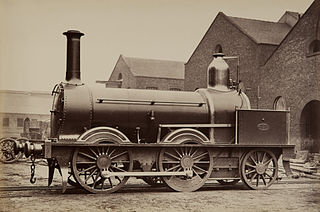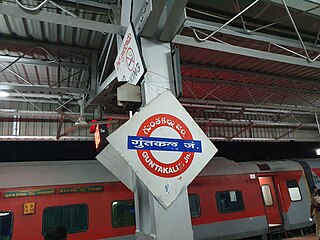
Rail transport in India consists of primarily of passenger and freight shipments along an integrated rail network. Indian Railways (IR), a statutory body under the ownership of the Ministry of Railways of the Government of India, operates India's national railway system. It is the primary owner and operator of rail operations throughout the country including suburban rail in major metros.

Indian Railways (IR) is a statutory body under the ownership of the Ministry of Railways of the Government of India that operates India's national railway system. As of 2023, it manages the fourth largest national railway system by size with a running track length of 104,647 km (65,025 mi) and route length of 68,426 km (42,518 mi) of which 60,451 km (37,563 mi) is electrified. With more than 1.2 million employees, it is the world's ninth-largest employer and India's second largest employer.

The Nilgiri Mountain Railway (NMR) is a 1,000 mmmetre gauge railway in Nilgiris district, Tamil Nadu, India, built by the British in 1908. The railway is operated by the Southern Railway and is the only rack railway in India.

Chennai Central (station code: MAS), is an NSG–1 category Indian railway station in Chennai railway division of Southern Railway zone. It is the main railway terminus in the city of Chennai, Tamil Nadu, India. It is the busiest railway station in South India and one of the most important hubs in the country. It is connected to Moore Market Complex railway station, Chennai Central metro station, Chennai Park railway station, and Chennai Park Town railway station. It is about 1.8 km (1.1 mi) from the Chennai Egmore railway station. The terminus connects the city to northern India, including Kolkata, Mumbai, and New Delhi, and different parts of India.

Perambur Loco Works is a suburban railway station in the Perambur area of the city of Chennai, in Tamil Nadu, in India. It serves the Integral Coach Factory (ICF) that is one of the largest railroad carriage and locomotive manufacturers in the world. The station serves growing areas like Periyar Nagar and Jawahar Nagar localities in the north-west corner of Chennai. The station has an elevation of 7.01 m above sea level.

Perambur Carriage Works railway station is a suburban railway station less than a kilometre from the Perambur railway station in Chennai, Tamil Nadu, India. The station has an elevation of 7.16 m above sea level. Mainly POH and IOH of all type of passenger coaches are undertaken here. The railway department has many facilities around this station, including a school, and an indoor sporting facility.

Perambur railway station is an NSG–3 category Indian railway station in Chennai railway division of Southern Railway zone. It is located in Perambur one of the important stations in Chennai, in the Chennai Beach/Chennai Central–Arakkonam section of the Chennai Suburban Railway network. This passenger station serves the city railway colony with its Southern Railway Headquarters Hospital and works, which have their own stations, Perambur Carriage Works railway station and Perambur Loco Works railway station.
Tamil Nadu, a state in South India, has a developed, dense, and modern transportation infrastructure, encompassing both public and private transport. Its capital city Chennai is well-connected by land, sea, and air and serves as a major hub for entry into South India.

Visakhapatnam Junction is an important railway station located in Visakhapatnam in the Indian state of Andhra Pradesh. It is on the Howrah–Chennai main line. It is operated by East coast Railway till now and it may take some time to administered under the South Coast Railway zone by Indian Railways. Originally named the Waltair railway station, it was founded in 1896. In 1987, it was renamed Visakhapatnam.

Royapuram railway station is a railway station at Royapuram, on the Chennai Beach–Walajapet section of the Chennai Suburban Railway network in Chennai, India. It is the second oldest railway station currently operational in India after Howrah railway station situated in Howrah, West Bengal and the first railway station of South India. The first train of South India started operating in June 1856 from Royapuram railway station. The station also remained the headquarters of the Madras and Southern Mahratta Railway till 1922, when the headquarters was shifted to Egmore. Since the original structures of Bombay and Thane stations no longer exist, Royapuram station remains the oldest railway station in the entire subcontinent.

The Howrah–Chennai main line is a railway line connecting Chennai and Kolkata cutting across Eastern Coastal Plains of India. It covers a distance of 1,661 kilometres (1,032 mi) across, West Bengal, Odisha, Andhra Pradesh and Tamil Nadu.

Madras Railway was one of the railway companies operating rail services in British India.
Mettupalayam railway station is an NSG–4 category Indian railway station in Salem railway division of Southern Railway zone. It is a railway station located in Mettupalayam, a suburb of Coimbatore district in the Indian state Tamil Nadu. It is one of the important railway stations located in the Coimbatore District, because the Nilgiri Mountain Railway to the hill station of Ooty starts from here. It is the connection between the metre-gauge Nilgiri Mountain Railway and the broad-gauge main network of Indian Railways. It recently celebrated its 150th anniversary.

Kollam Junction railway station is an NSG–3 category Indian railway station in Thiruvananthapuram railway division of Southern Railway zone.) It is a junction station situated in the city of Kollam in Kerala, India. It is the second largest railway station in Kerala in terms of area and largest in terms of number of tracks and one of the oldest railway stations in the state. It is also the second busiest railway station in Kerala in terms of trains handled per day. World's third longest railway platform is situated at Kollam railway station.

Guntakal Junction railway station is located in Anantapur district in the Indian state of Andhra Pradesh and serves Guntakal. It is also the headquarters of Guntakal railway division in South Central Railway. It is a junction station at the intersection point of the Mumbai–Chennai line, the Vijayawada–Marmagova line and the Guntakal–Bengaluru line.

The Chennai Central – Bangalore City line is an electrified railway double line which connects Chennai and Bengaluru, the two largest cities in South India. It is officially known as Puratchi Thalaivar Dr. M.G. Ramachandran Central Railway Station–Krantivira Sangolli Rayanna line, and earlier known as Madras–Bangalore line.

The Chennai Egmore–Thanjavur main line connects Chennai Egmore and Thanjavur Junction both in the Indian state of Tamil Nadu. The Chennai Egmore–Thanjavur main line is part of Chennai–Viluppuram–Chidambaram-Mayiladuthurai–Kumbakonam–Thanjavur–Tiruchirappalli line. There are several branch lines : Chengalpattu–Arakkonam links to Chennai Central–Bengaluru City line, Guntakal–Chennai Egmore section, Viluppuram–Puducherry, Cuddalore–Virudhachalam, Mayiladuthurai–Thiruvarur, and Peralam–Nagapattinam sectors. The line connects the Kaveri delta to Chennai.

The 12669 / 12670 Ganga Kaveri Express is a bi-weekly Express train service operated by Indian Railways, connecting Chennai in Southern India to Chhapra in Bihar. Inaugurated on 16 February 1977 by Kamalpati Tripathi, between Madras and Varanasi, was terminating at Chennai Beach Station, from where MG Ganga Kaveri Express used to run to Rameswaram through the Kaveri river basin. From May 2, 2022, it will run with the new highly refurbished LHB coach.
Tiruppattur Junction railway station is an NSG–5 category Indian railway station in the Salem railway division of the Southern Railway zone. It is a railway station serving the town of Tiruppattur in Tamil Nadu, India.
This is the timeline for Southern Railway zone that encompasses over present day Tamil Nadu, Kerala and parts of Andhra Pradesh and Karnataka.

























